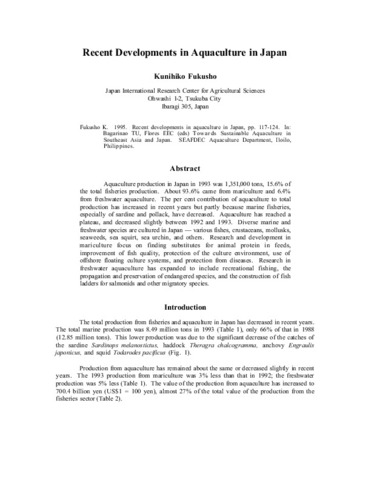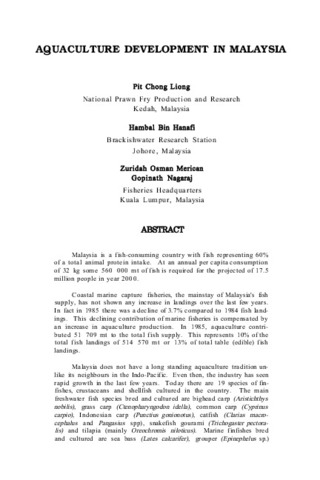Recent developments in aquaculture in Japan
- Global styles
- MLA
- Vancouver
- Elsevier - Harvard
- APA
- Help

Date
1995Author
Page views
9,567ASFA keyword
fishery economics 
feeds
crustacean culture
disease control
mollusc culture
seed production
rare species
aquaculture
environmental factors
environmental protection
sport fishing
feed composition
aquaculture economics
migratory species
aquaculture development
cage culture
seaweed culture
mariculture
research
freshwater aquaculture
fish culture
floating cages
Echinoderms
fishing
fish ladders
fish
floating
Mollusks
Algae

feeds

crustacean culture

disease control

mollusc culture

seed production

rare species

aquaculture

environmental factors

environmental protection

sport fishing

feed composition

aquaculture economics

migratory species

aquaculture development

cage culture

seaweed culture

mariculture

research

freshwater aquaculture

fish culture

floating cages

Echinoderms

fishing

fish ladders

fish

floating

Mollusks

Algae

AGROVOC keyword
Metadata
Show full item record
Share
Abstract
Aquaculture production in Japan in 1993 was 1,351,000 tons, 15.6% of the total fisheries production. About 93.6% came from mariculture and 6.4% from freshwater aquaculture. The per cent contribution of aquaculture to total production has increased in recent years but partly because marine fisheries,especially of sardine and pollack, have decreased. Aquaculture has reached a plateau, and decreased slightly between 1992 and 1993. Diverse marine and freshwater species are cultured in Japan — various fishes, crustaceans, mollusks, seaweeds, sea squirt, sea urchin, and others. Research and development in mariculture focus on finding substitutes for animal protein in feeds, improvement of fish quality, protection of the culture environment, use of offshore floating culture systems, and protection from diseases. Research in freshwater aquaculture has expanded to include recreational fishing, the propagation and preservation of endangered species, and the construction of fish ladders for salmonids and other migratory species.
Suggested Citation
Fukusho, K. (1995). Recent developments in aquaculture in Japan. In T. U. Bagarinao & E. E. C. Flores (Eds.), Towards Sustainable Aquaculture in Southeast Asia and Japan: Proceedings of the Seminar-Workshop on Aquaculture Development in Southeast Asia, Iloilo City, Philippines, 26-28 July, 1994 (pp. 117-124). Tigbauan, Iloilo, Philippines: Aquaculture Department, Southeast Asian Fisheries Development Center.
Type
Conference paperISBN
971851127XCollections
- ADSEA '94 [21]
Related items
Showing items related by title, author, creator and subject.
-
Aquaculture development in Thailand
Sirikul, Boonsong; Luanprida, Somsak; Chaiyakam, Kanit; Sriprasert, Revadee (Aquaculture Department, Southeast Asian Fisheries Development Center, 1988)Aquaculture practised in Thailand is in the form of pond culture and cage culture in freshwater, brackishwater and coastal areas. The main species cultured include freshwater prawns, brackishwater shrimp, cockles, mussels, ... -
Aquaculture development in Malaysia
Liong, Pit Chong.; Hanafi, Hambal Bin.; Merican, Zuridah Osman.; Nagaraj, Gopinath. (Aquaculture Department, Southeast Asian Fisheries Development Center, 1988)Malaysia is a fish-consuming country with fish representing 60% of a total animal protein intake. At an annual per capita consumption of 32 kg some 560 000 mt of fish is required for the projected of 17.5 million people ... -
The Philippine aquaculture industry
Camacho, Arsenio S.; Macalincag-Lagua, Natividad (Aquaculture Department, Southeast Asian Fisheries Development Center, 1988)The aquaculture sector of the Philippine fishing industry registered the highest growth rate of 12.5% in 1977-1986. The contribution of aquaculture to the total fish production was equivalent to 24% in 1986 compared to ...




